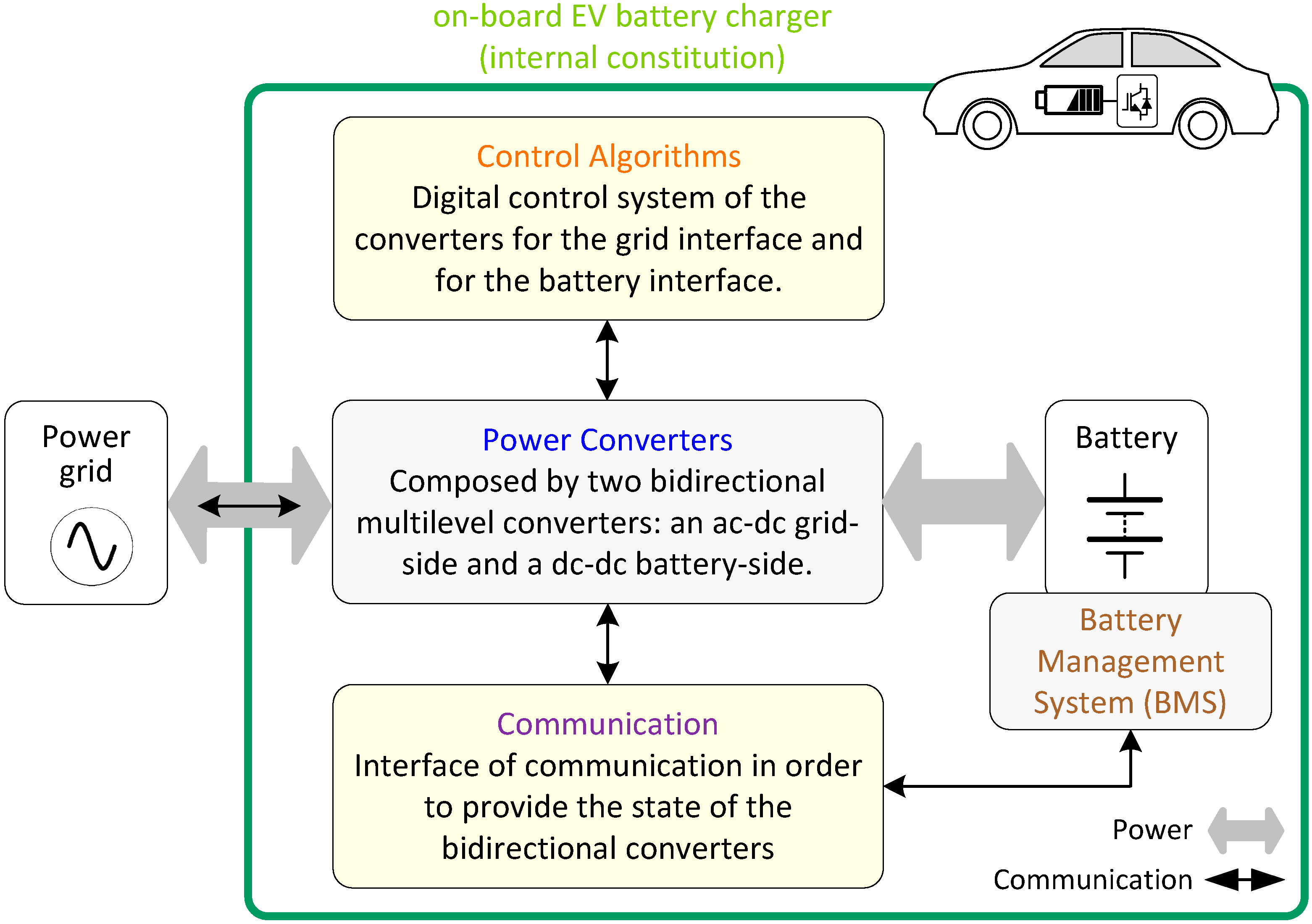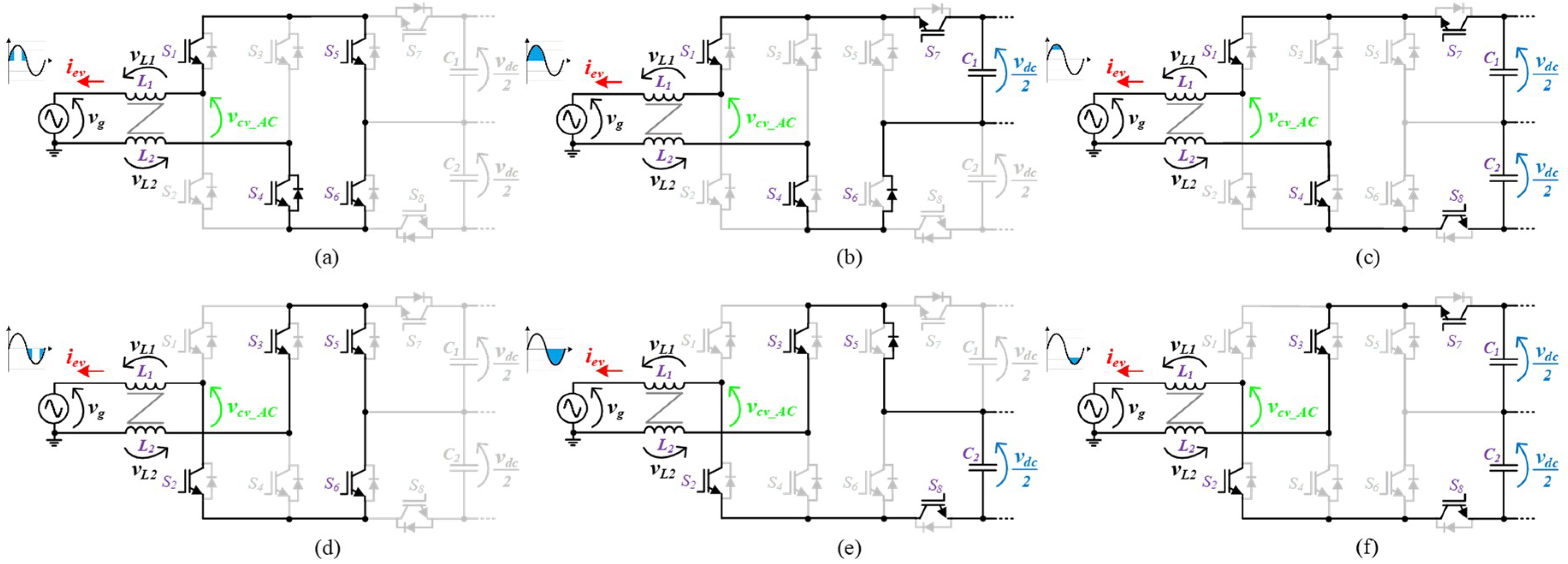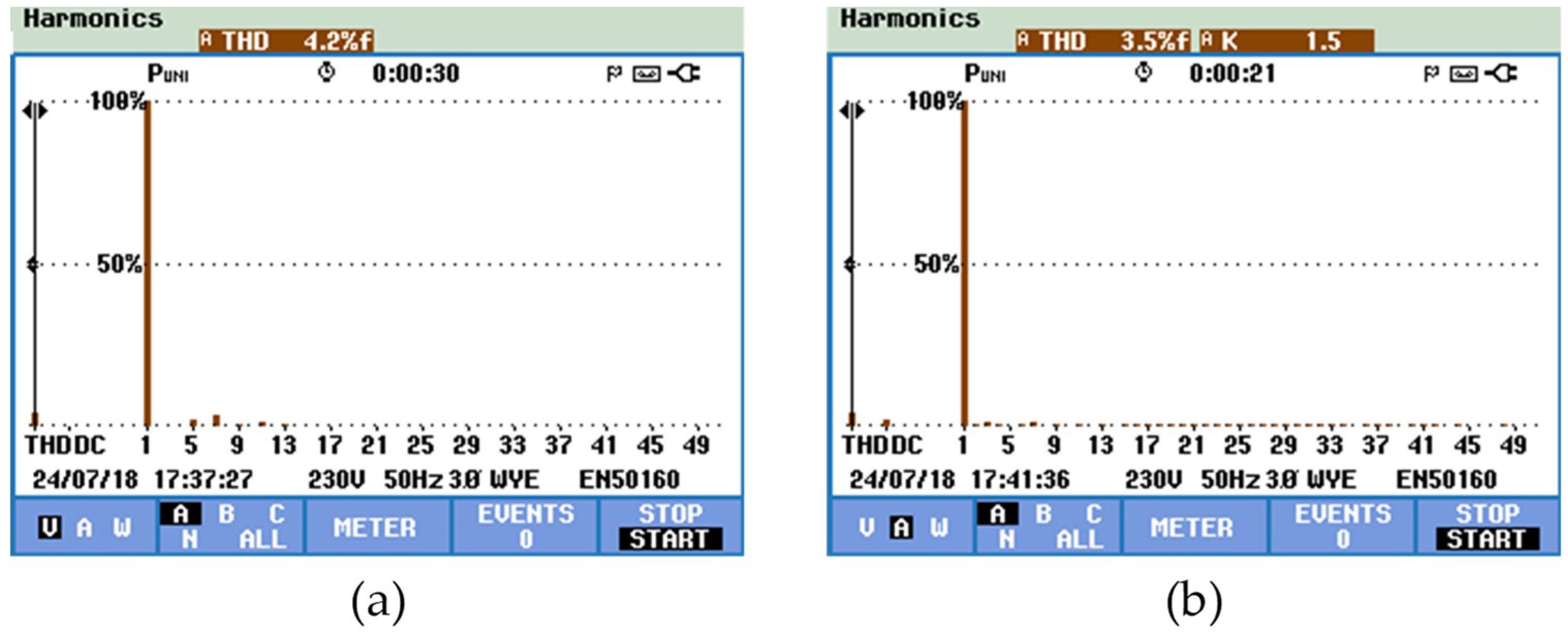A Novel Multilevel Bidirectional Topology for On-Board EV Battery Chargers in Smart Grids
Abstract
:1. Introduction
2. EV Battery Charger: Topology Description
2.1. Topology Description: Grid-Side Converter
2.2. Topology Description: Battery-Side Converter
3. EV Battery Charger: Control Algorithms
3.1. Control Algorithm: Grid-Side Converter
3.2. Control Algorithm: Battery-Side Converter
4. EV Battery Charger: Experimental Validation
4.1. Description of the Developed Prototype
4.2. Experimental Results
4.2.1. Experimental Results: Grid-To-Vehicle (G2V) Operation
4.2.2. Experimental Results: Vehicle-To-Grid (V2G) Operation
5. Conclusions
Author Contributions
Funding
Conflicts of Interest
References
- Idaho National Laboratory. Charging and Driving Behavior of Nissan Leaf Drivers in the EV Project with Access to Workplace Charging; EV Project; Idaho National Laboratory: Idaho Falls, ID, USA, 2014; pp. 1–4.
- Matthé, R.; Eberle, U. The Voltec System—Energy Storage and Electric Propulsion. In Lithium-Ion Batteries—Advances and Applications; Elsevier: Amsterdam, The Netherlands, 2014; pp. 151–176. [Google Scholar]
- Robledo, C.B.; Oldenbroek, V.; Abbruzzese, F.; van Wijk, A.J.M. Integrating a hydrogen fuel cell electric vehicle with vehicle-to-grid technology, photovoltaic power and a residential building. Appl. Energy 2018, 215, 615–629. [Google Scholar] [CrossRef]
- Boulanger, A.G.; Chu, A.C.; Maxx, S.; Waltz, D.L. Vehicle Electrification: Status and Issues. Proc. IEEE 2011, 99, 1116–1138. [Google Scholar] [CrossRef] [Green Version]
- Rajashekara, K. Present Status and Future Trends in Electric Vehicle Propulsion Technologies. IEEE J. Emerg. Sel. Top. Power Electron. 2013, 1, 3–10. [Google Scholar] [CrossRef]
- Milberg, J.; Schlenker, A. Plug into the Future. IEEE Power Energy Mag. 2011, 9, 56–65. [Google Scholar] [CrossRef]
- Monteiro, V.; Ferreira, J.C.; Melendez, A.A.N.; Couto, C.; Afonso, J.L. Experimental Validation of a Novel Architecture Based on a Dual-Stage Converter for Off-Board Fast Battery Chargers of Electric Vehicles. IEEE Trans. Veh. Technol. 2018, 67, 1000–1011. [Google Scholar] [CrossRef]
- Basu, M.; Gaughan, K.; Coyle, E. Harmonic distortion caused by EV battery chargers in the distribution systems network and its remedy. In Proceedings of the International Conference UPEC—Universities Power Engineering Conference, Bristol, UK, 6–8 September 2004; pp. 869–873. [Google Scholar]
- Monteiro, V.; Pinto, J.G.; Afonso, J.L. Operation Modes for the Electric Vehicle in Smart Grids and Smart Homes: Present and Proposed Modes. IEEE Trans. Veh. Technol. 2016, 65, 1007–1020. [Google Scholar] [CrossRef] [Green Version]
- Kisacikoglu, M.C.; Ozpineci, B.; Tolbert, L.M. Examination of a PHEV Bidirectional Charger System for V2G Reactive Power Compensation. In Proceedings of the IEEE APEC Applied Power Electronics Conference and Exposition, Palm Springs, CA, USA, 21–25 February 2010; pp. 458–465. [Google Scholar]
- Monteiro, V.; Ferreira, J.C.; Meléndez, A.A.N.; Afonso, J.L. Electric Vehicles On-Board Battery Charger for the Future Smart Grids. In Technological Innovation for the Internet of Things, 1st ed.; Camarinha-Matos, L.M., Tomic, S., Graça, P., Eds.; Springer: Berlin, Germany, 2013; Chapter 38; pp. 351–358. [Google Scholar]
- Multin, M.; Allerding, F.; Schmeck, H. Integration of Electric Vehicles in Smart Homes—An ICT-based Solution for V2G Scenarios. In Proceedings of the IEEE ISGT PES Innovative Smart Grid Technologies, Washington, DC, USA, 16–20 January 2012; pp. 1–8. [Google Scholar]
- Wong, N.; Kazerani, M. A Review of Bidirectional On-Board Charger Topologies for Plug-In Vehicles. In Proceedings of the IEEE CCECE Canadian Conference on Electrical and Computer Engineering, Montreal, QC, Canada, 29 April–2 May 2012; pp. 1–6. [Google Scholar]
- Mei, J.; Xiao, B.; Shen, K.; Tolbert, L.M.; Zheng, J.Y. Modular Multilevel Inverter with new Modulation Method and its Application to Photovoltaic Grid-Connected Generator. IEEE Trans. Power Electron. 2013, 28, 5063–5073. [Google Scholar] [CrossRef]
- Tolbert, L.M.; Peng, F.Z.; Habetler, T.G. Multilevel Converters for Large Electric Drives. IEEE Trans. Ind. Appl. 1999, 35, 36–44. [Google Scholar] [CrossRef]
- Wang, H.; Kou, L.; Liu, Y.-F.; Sen, P.C. A New Six-Switch Five-Level Active Neutral Point Clamped Inverter for PV Applications. IEEE Trans. Power Electron. 2017, 32, 6700–6715. [Google Scholar] [CrossRef]
- Monteiro, V.; Meléndez, A.A.N.; Afonso, J.L. Novel Single-Phase Five-Level VIENNA-Type Rectifier with Model Predictive Current Control. In Proceedings of the IEEE IECON Industrial Electronics Conference, Beijing, China, 29 October–1 November 2017; pp. 6413–6418. [Google Scholar]
- Grbovic, P.; Lidozzi, A.; Solero, L.; Crescimbini, F. Five-Level Unidirectional T-Rectifier for High Speed Gen-Set Applications. IEEE Trans. Ind. Appl. 2016, 52, 1642–1651. [Google Scholar] [CrossRef]
- Monteiro, V.; Ferreira, J.C.; Meléndez, A.A.N.; Afonso, J.L. Model Predictive Control Applied to an Improved Five-Level Bidirectional Converter. IEEE Trans. Ind. Electron. 2016, 63, 5879–5890. [Google Scholar] [CrossRef] [Green Version]
- Monteiro, V.; Meléndez, A.A.N.; Ferreira, J.C.; Couto, C.; Afonso, J.L. Experimental Validation of a Proposed Single-Phase Five-Level Active Rectifier Operating with Model Predictive Current Control. In Proceedings of the IEEE IECON Industrial Electronics Conference, Yokohama, Japan, 9–12 November 2015; pp. 3939–3944. [Google Scholar]
- Mokhberdoran, A.; Ajami, A. Symmetric and Asymmetric Design and Implementation of New Cascaded Multilevel Inverter Topology. IEEE Trans. Power Electron. 2014, 29, 6712–6724. [Google Scholar] [CrossRef]
- Elsheikh, M.G.; Ahmed, M.E.; Abdelkarem, E.; Orabi, M. Single-Phase Five-Level Inverter with Less Number of Power Elements. In Proceedings of the IEEE INTELEC International Telecommunications Energy Conference, Orlando, FL, USA, 5–9 February 2012; pp. 1–8. [Google Scholar]
- Loukriz, A.H.; Dudley, S.; Quinlan, T.; Walker, S.D. Experimental Realization of a Single-Phase Five Level Inverter for PV Applications. In Proceedings of the IEEE COMPEL Control and Modeling for Power Electronics, Trondheim, Norway, 27–30 June 2016; pp. 1–6. [Google Scholar]
- Wang, K.; Xu, L.; Zheng, Z.; Li, Y. Capacitor Voltage Balancing of a Five-Level ANPC Converter Using Phase-Shifted PWM. IEEE Trans. Power Electron. 2015, 30, 1147–1156. [Google Scholar] [CrossRef]
- Monteiro, V.; Pinto, J.G.; Sousa, T.J.C.; Meléndez, A.A.N.; Afonso, J.L. A Novel Single-Phase Five-Level Active Rectifier for On-Board EV Battery Chargers. In Proceedings of the IEEE ISIE International Symposium on Industrial Electronics, Edinburgh, UK, 19–21 June 2017; Volume 4, pp. 582–587. [Google Scholar]
- Rosas-Caro, J.C.; Ramírez, J.M.; García-Vite, P.M. Novel DC-DC Multilevel Boost Converter. In Proceedings of the IEEE Power Electronics Specialists Conference, Rhodes, Greece, 15–19 June 2008; pp. 2146–2151. [Google Scholar]
- Zhang, F.; Peng, F.Z.; Qian, Z. Study of the Multilevel Converters in DC-DC Applications. In Proceedings of the IEEE Annual Power Electronics Specialists Conference, Aachen, Germany, 20–25 June 2004. [Google Scholar]
- Lee, P.; Lee, Y.; Cheng, D.K.W. Steady-state analysis of an interleaved boost converter with coupled inductors. IEEE Trans. Ind. Electron. 2000, 47, 787–795. [Google Scholar] [CrossRef]
- Jiang, W.; Fahimi, B. Phase-Shift Controlled Multilevel Bidirectional DC/DC Converter: A Novel Solution to Battery Charge Equalization in Fuel Cell Vehicle. In Proceedings of the IEEE Vehicle Power and Propulsion Conference, Arlington, TX, USA, 9–12 September 2007; pp. 587–590. [Google Scholar]

























| Parameter | Value | Unit | |
|---|---|---|---|
| Inductive Passive Filter | L1, L2 | 5 | mH |
| Inductive Passive Filter | L3, L4 | 2.5 | mH |
| Capacitive Passive Filter | C1, C2 | 2.24 | mF |
| Capacitive Passive Filter | C3 | 20 | µF |
| Nominal Input Voltage (grid-side) | vg | 230 ± 10% | V |
| Nominal Grid Frequency | f | 50 ± 1% | Hz |
| Nominal Input Current (grid-side) | iev | 16 | A |
| Total Harmonic Distortion (grid current) | - | <5% | - |
| Total Power Factor | - | 1 | - |
| Nominal DC-link Voltage | vdc | 400 | V |
| Nominal Output Voltage (battery-side) | vbat | 200–400 | V |
| Nominal Output Current (battery-side) | ibat | 10 | A |
| Switching Frequency | fsw | 20 | kHz |
| Sampling Frequency | fs | 40 | kHz |
© 2018 by the authors. Licensee MDPI, Basel, Switzerland. This article is an open access article distributed under the terms and conditions of the Creative Commons Attribution (CC BY) license (http://creativecommons.org/licenses/by/4.0/).
Share and Cite
Leite, R.S.; Afonso, J.L.; Monteiro, V. A Novel Multilevel Bidirectional Topology for On-Board EV Battery Chargers in Smart Grids. Energies 2018, 11, 3453. https://doi.org/10.3390/en11123453
Leite RS, Afonso JL, Monteiro V. A Novel Multilevel Bidirectional Topology for On-Board EV Battery Chargers in Smart Grids. Energies. 2018; 11(12):3453. https://doi.org/10.3390/en11123453
Chicago/Turabian StyleLeite, Rafael S., João L. Afonso, and Vítor Monteiro. 2018. "A Novel Multilevel Bidirectional Topology for On-Board EV Battery Chargers in Smart Grids" Energies 11, no. 12: 3453. https://doi.org/10.3390/en11123453
APA StyleLeite, R. S., Afonso, J. L., & Monteiro, V. (2018). A Novel Multilevel Bidirectional Topology for On-Board EV Battery Chargers in Smart Grids. Energies, 11(12), 3453. https://doi.org/10.3390/en11123453







